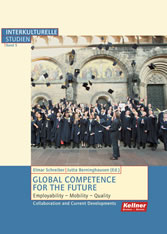Suchen und Finden
Service
Global Competence for the Future - Employability - Mobility - Quality. Collaboration and Current Developments
Jutta Berninghausen, Elmar Schreiber
Verlag Kellner-Verlag, 2009
ISBN 9783939928294 , 254 Seiten
Format PDF, OL
Kopierschutz DRM
Enhancing Quality (p. 168-170)
Stefan Bienefeld
Developments in Structures of Quality Assurance Systems In Europe: More of A Dynamic Reform Process or A Step Back?
Introduction
Quality assurance and enhancements have been at the heart of the Bologna Process of creating a European higher education area. The number of meetings, conferences and organizations dealing with quality assurance is increasing at a dramatic pace.
When entering “Quality Management” into the Google search, you will receive 70,500,000 hits, adding “higher education” narrows that down to 6,470,000. “Quality assurance” results in 26,300,000 hits, with the addition of higher education you still get roughly 600,000. It seems that quality and assurance are very much “en vogue” at the moment. But what does quality assurance really mean with regards to higher education? And how much progress have we truly made in recent years towards more comparability and compatibility of systems in Europe and beyond?
The saying, “It’s better to light a candle than complain while sitting in the dark” is attributed to the Chinese philosopher Kong Zi (Confucius). Following that line of thought, this contribution will seek to answer some of the questions raised above, however preliminary these answers may be.
At first an attempt is made to shed some light on the multiple dimensions of the word “quality” and come up with some attempts at a definition of this from different stakeholders’ perspectives. This is to answer the seemingly easy question: “What is quality?” Secondly, a brief and very rough overview will be given with regards to the history of quality assurance in the higher education sector(s) in Europe. We will then move on to discuss in more detail the current state of affairs in QA in Europe by taking a closer look at the “European Standards and Guidelines for Quality Assurance in the European Higher Education Area” (ESG). In the remaining two paragraphs, a look is taken at changes from control towards enhancement and quality culture. Lastly, some attempts at conclusions are made.
What is quality?
“Quality…you know what it is, yet you don’t know what it is. But that’s self-contradictory. But some things are better than others, that is, they have more quality. But when you try to say what the quality is, apart from the things that have it, it all goes poof! There’s nothing to talk about. But if you can’t say what quality is, how do we know what it is, or how do we know that it even exists? If no one knows what it is, then for all practical purposes it doesn’t exist at all. But for practical purposes it really does exist. What else are the grades based on? Why else would people pay fortunes for some things and throw others in the trash pile? Obviously some things are better than others…but what’s the better-ness? So round and round you go, spinning mental wheels and nowhere finding any place to get traction. What the hell is Quality? What is it?” – Robert M. Pirsig, Zen and the Art of Motorcycle Maintenance (1974)



